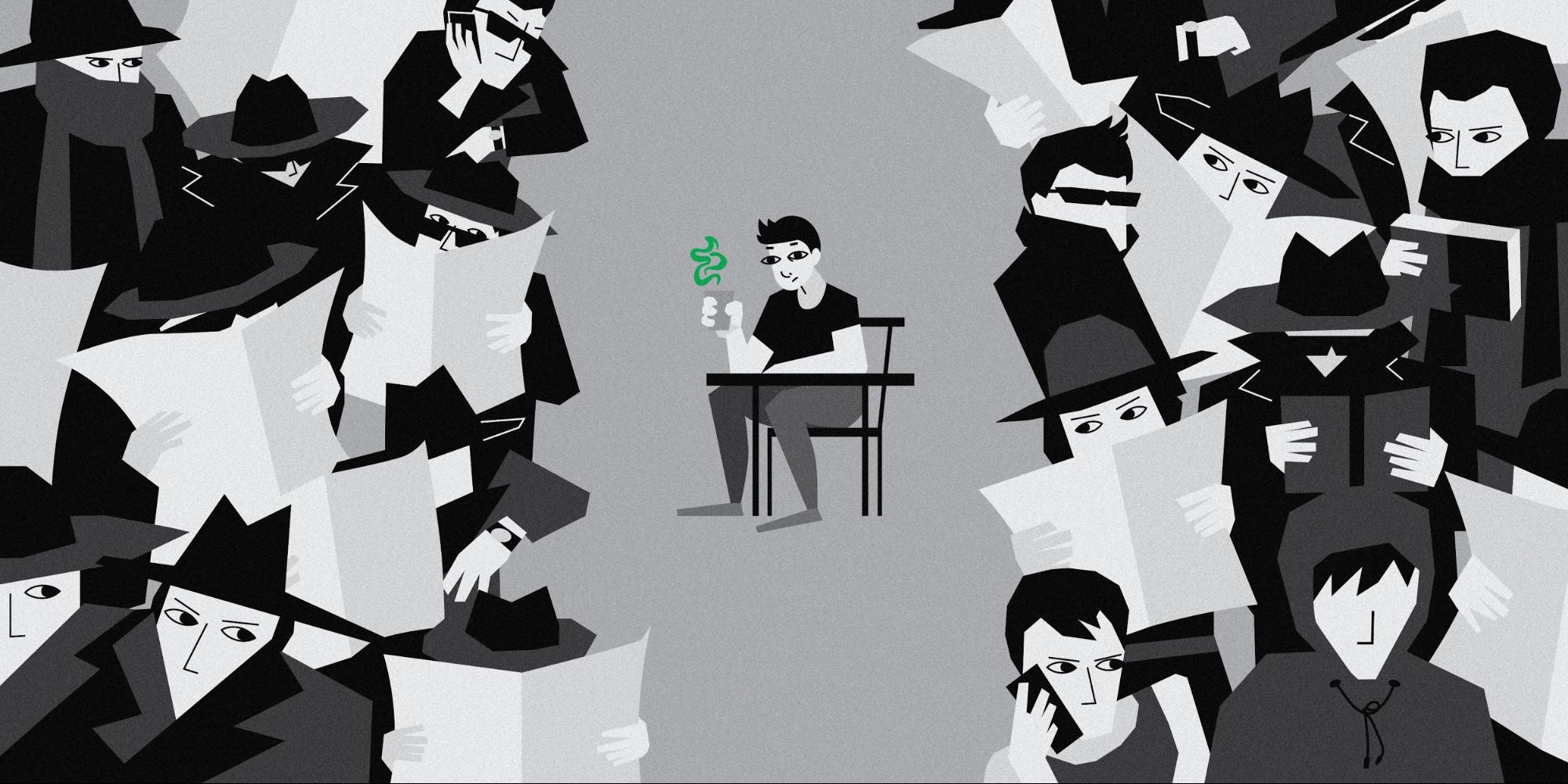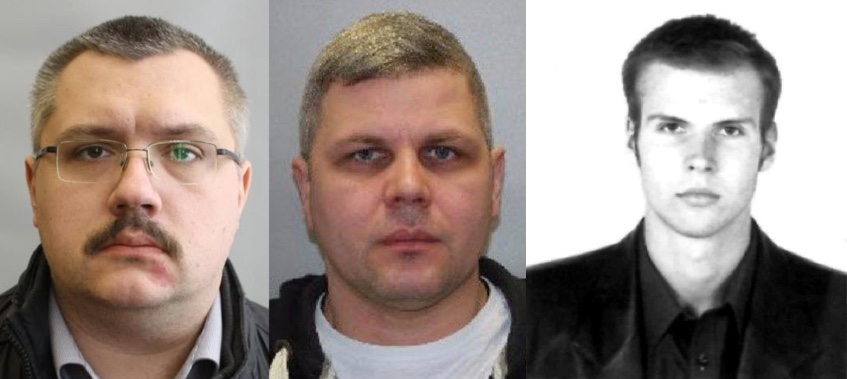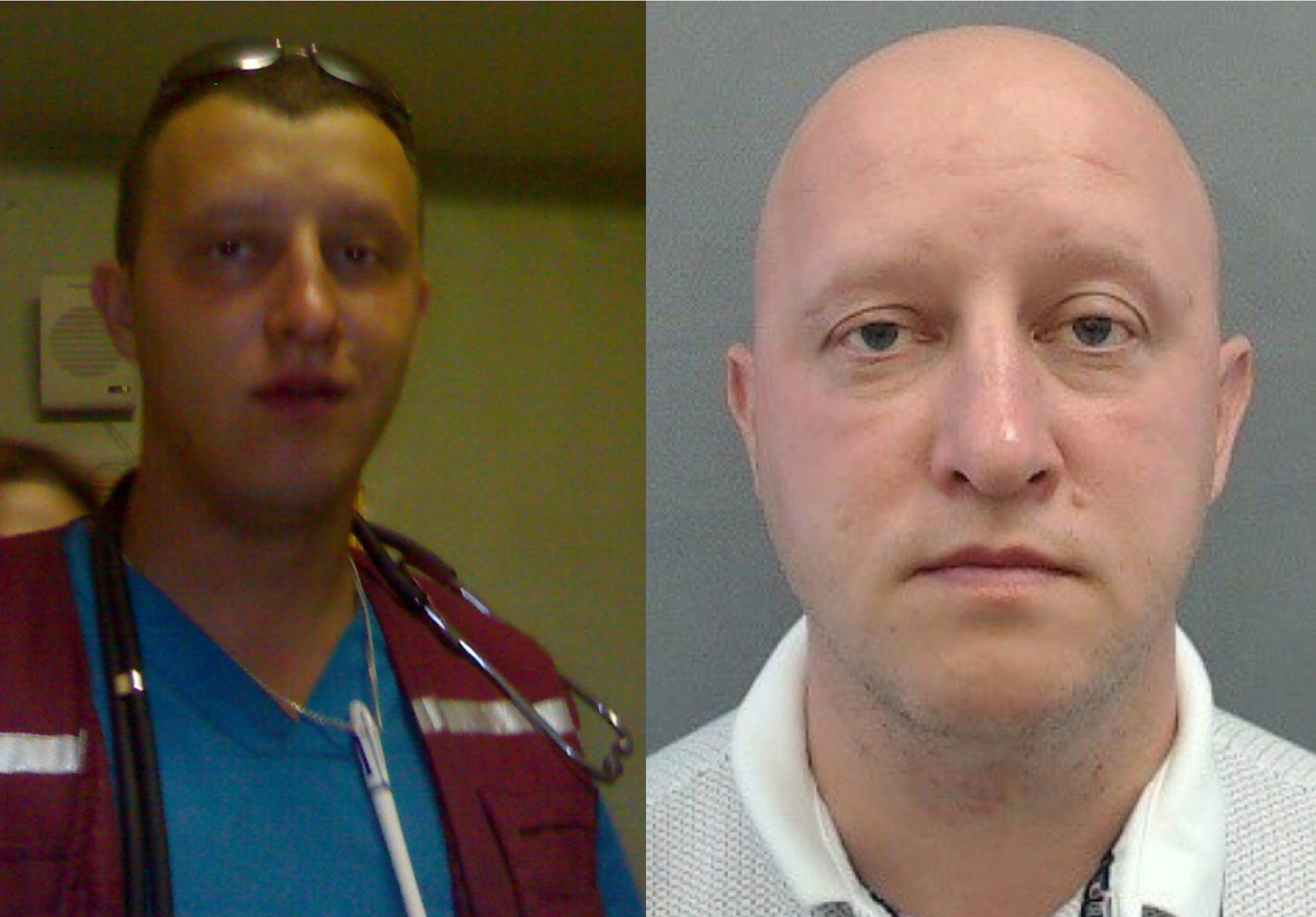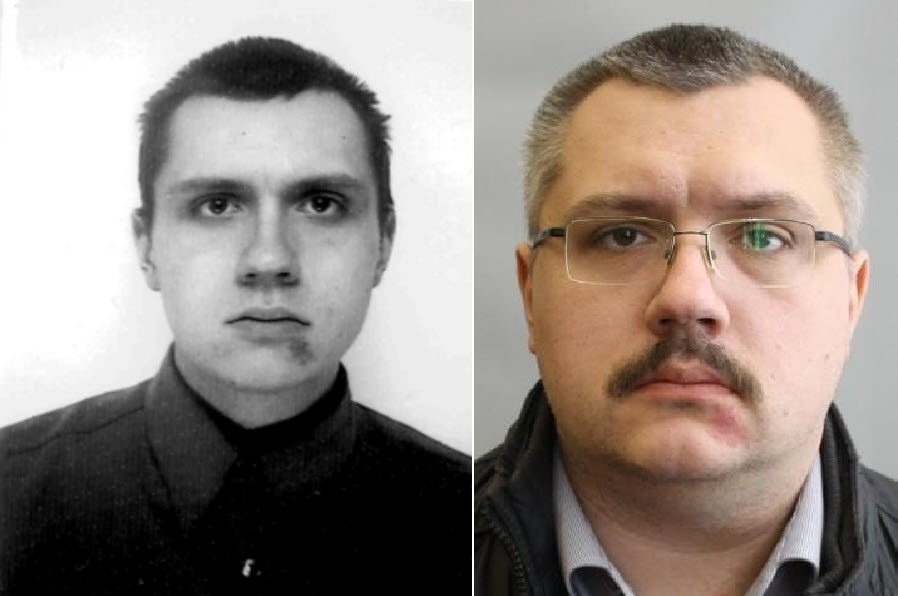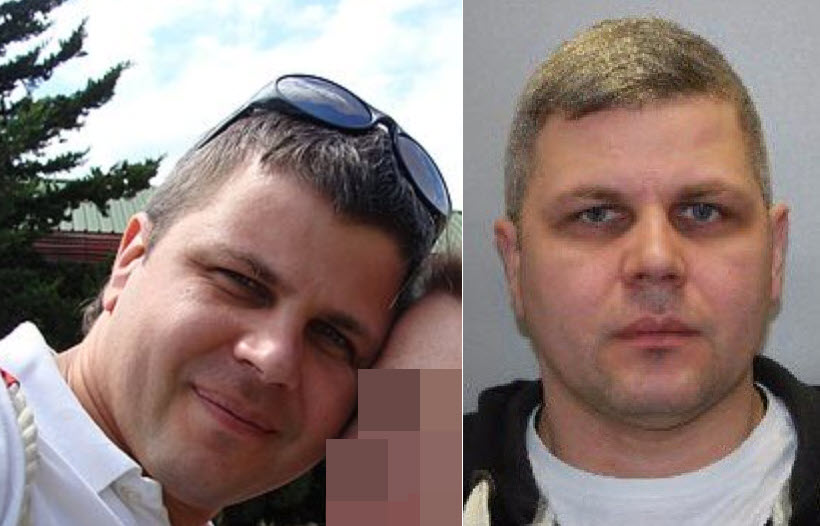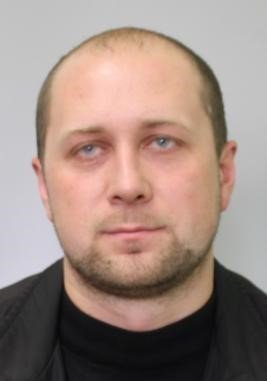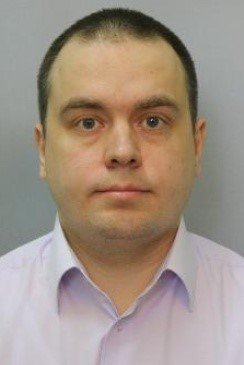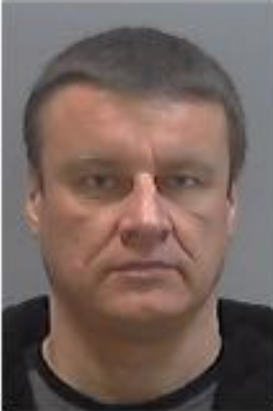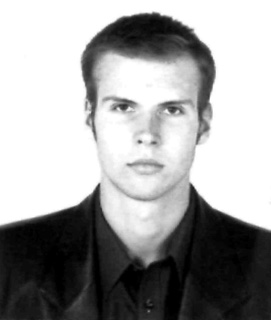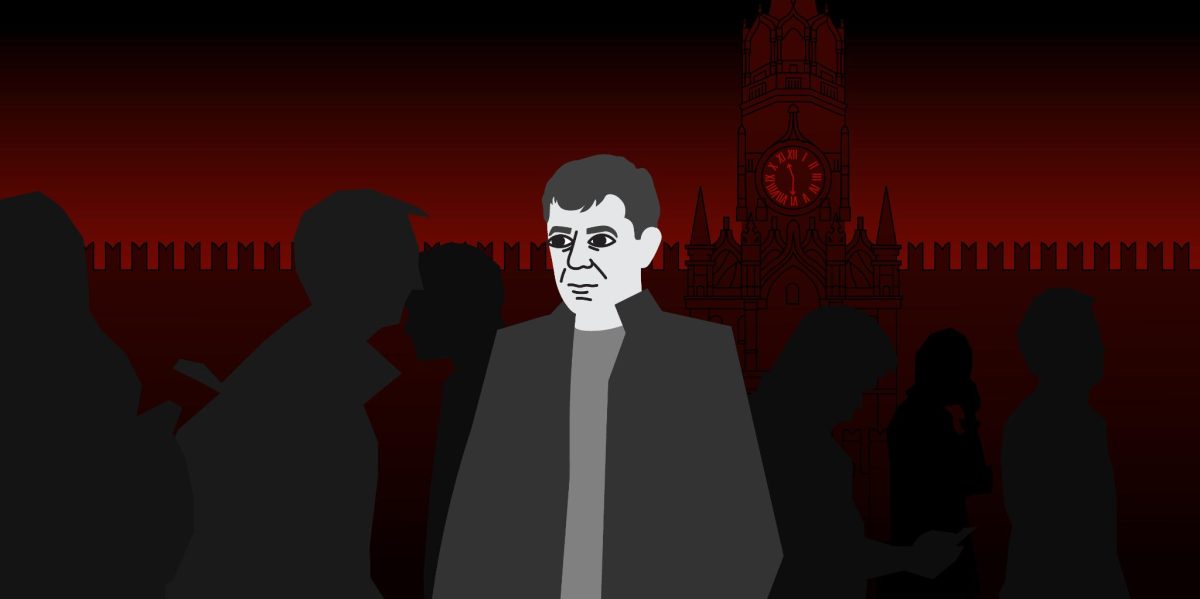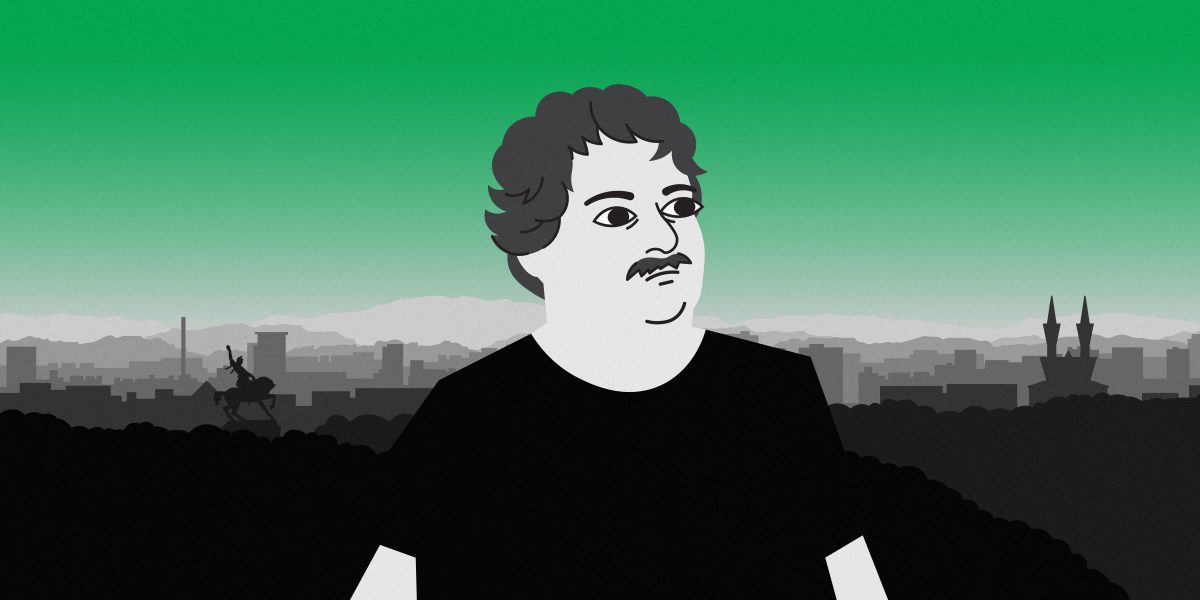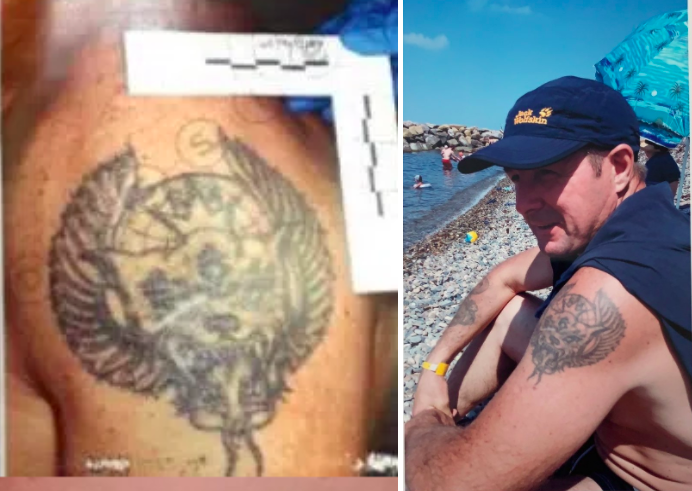FSB Team of Chemical Weapon Experts Implicated in Alexey Navalny Novichok Poisoning
We have detailed the research methodology for this investigation into a separate article. You can read it here.
- In a previous series of investigations, Bellingcat uncovered evidence that Russia’s military intelligence agency – the GRU – was responsible for both the Novichok poisoning of Sergey and Yulia Skripal in the U.K. (an assassination attempt that led to the death of one British citizen) and the poisoning of Emilian Gebrev in Bulgaria. We also determined that Russia’s principal security agency – the FSB – was behind the assassination of a Georgian asylum seeker on German soil.
- In a further joint investigation, Bellingcat uncovered evidence that Russia has not terminated its chemical weapons program, but has instead disguised its development capability behind a network of state-run institutes. Following the official closure of Russia’s military-run chemical weapons program in 2010, its core scientists were rehired by institutes which engage in ostensibly civilian research. In reality, these scientists continued to provide chemical weapons development and manufacturing support to Russia’s security services.
- We identified two institutes which since 2010 appear to have taken the lead role in the continued R&D of Soviet-era nerve-agent programs, including those of the Novichok type. These institutes – the St Petersburg-based GNII VM and the Moscow-based SC Signal – were shown to have been in close communication with GRU operatives linked to the two overseas assassination attempts using military-grade toxins. SC Signal, formally engaged in developing sports nutrition drinks, appears to have focused research into nano-encapsulation; a relatively new technology that could permit a lethal toxin to be “packaged” within a veneer of another substance, allowing both obfuscation and delayed onset of the poison.
- On 20 August 2020, Russian opposition activist Alexey Navalny collapsed into a coma during a flight from the Siberian city of Tomsk to Moscow, resulting in an emergency landing and his hospitalization in the town of Omsk. Local doctors and medical specialists flown in from Moscow claimed that they found no signs of severe poisoning. Two days later, Navalny was evacuated to the German Charite hospital where he was promptly diagnosed with severe poisoning with a cholinesterase inhibitor. A German military laboratory, two independent European labs and the Organization for the Prohibition of Chemical Weapons (OPCW) all identified the toxin as a nerve agent belonging to the Novichok group. The OPCW identified the toxin as a cholinesterase inhibitor structurally resembling the known Novichok variants, but one that was not included in the list of banned nerve agents updated after the Skripal poisoning in 2018. This implied that the agent used on Navalny was of a more recent, previously unknown type.
- The U.S. and European governments have blamed the Russian government, and in particular the FSB, for Navalny’s near-fatal poisoning. Russia has repeatedly denied the accusation and claims that the opposition figure had no traces of nerve agents in his body while in Russia, and that if he was poisoned with a Novichok-type nerve agent, this must have happened after he left Russian territory.
- No law enforcement agency in any country is currently investigating the poisoning of Alexey Navalny.
A joint investigation between Bellingcat and The Insider, in cooperation with Der Spiegel and CNN, has discovered voluminous telecom and travel data that implicates Russia’s Federal Security Service (FSB) in the poisoning of the prominent Russian opposition politician Alexey Navalny. Moreover, the August 2020 poisoning in the Siberian city of Tomsk appears to have happened after years of surveillance, which began in 2017 shortly after Navalny first announced his intention to run for president of Russia. Throughout 2017, and again in 2019 and 2020, FSB operatives from a clandestine unit specialized in working with poisonous substances shadowed Navalny during his trips across Russia, traveling alongside him on more than 30 overlapping flights to the same destinations. It is also possible there were earlier attempts to poison Navalny, including one in the Western Russian city of Kaliningrad only a month before the near-fatal Novichok poisoning in Siberia.

Click to view in full resolution. Credit: Bellingcat
Our investigation identified three FSB operatives from this clandestine unit who traveled alongside Navalny to Novosibirsk and then followed him to the city of Tomsk where he was ultimately poisoned. These operatives, two of whom traveled under cover identities, are Alexey Alexandrov (39), Ivan Osipov (44) – both medical doctors – and Vladimir Panyaev (40). These three were supported and supervised by at least five more FSB operatives, some of whom also traveled to Omsk, where Navalny had been hospitalized. Members of the unit communicated with one another throughout the trip, with sudden peaks of communication just before the poisoning as well as during the night-time hours (Moscow time) when Navalny left his hotel and headed to the Tomsk airport.
In the course of this investigation, Bellingcat and its partners also uncovered data pointing to the existence of a clandestine chemical weapons program operated by members of Russia’s domestic intelligence services (FSB). Both phone logs and employment records show that this program is run under the cover of an FSB unit formally tasked with carrying out forensic investigations of terrorist acts and hi-tech crime prevention. However, while the latter has some legitimate investigative activity, one of its key and secretive roles has been to provide cover for a clandestine sub-unit comprising approximately 15 operatives with backgrounds in chemical and biological warfare, medicine, and special operations.
This sub-unit appears to report to a scientist who previously worked in Russia’s military chemical weapons program in Shikhany, where nerve agents from the Novichok family were originally developed, and is supported by a network of other chemical weapons specialists dispersed at several government-run institutes. SC Signal, previously identified by Bellingcat, is one of these institutes.
Our investigation also unearthed telecoms and travel data that strongly suggests the August poisoning attempt on Navalny’s life was mandated at the highest echelons of the Kremlin.
This report for the first time reveals data that directly links the August 2020 poisoning of Navalny to Russia’s domestic security services. This investigation is particularly important due to the legal vacuum in which no country other than Russia – the country implicated in the assassination attempt – has offered its jurisdiction for an official investigation into Navalny’s near-fatal poisoning.
FSB’s Poisonous Criminalistics Institute Unit
Telecoms and travel data obtained and analyzed by Bellingcat and its partners shows that Navalny had for years been tailed by a team of operatives from a clandestine FSB unit. Members of this team communicated with experts in organophosphate toxins in the weeks prior to Navalny’s August 2020 trip to Siberia and intensely tailed him throughout this time, especially in the days and hours before his poisoning in Tomsk. This team operates under the guise of the FSB Criminalistics Institute, also referred to as NII-2 (Research Institute – 2), or as Military Unit 34435.
What is the FSB Criminalistics Institute?
The sprawling organization, originally established in 1977 as a KGB hi-tech investigative unit, provides services ranging from polygraph testing, voice and facial recognition to robotized bomb diffusion. The unit played a key role in investigating all major security incidents in post-Soviet Russia, such as the 1999 apartment bombings, the Kursk submarine explosion, the Nord-Ost and Beslan school siege, as well as the St Petersburg metro bombings. This FSB unit has also claimed some more esoteric achievements, such as the ability to determine a suspect’s stature and education background based on a voice sample, and the exact manner of death of Jesus Christ.
The unit has also taken part in what appear to be politically motivated projects, such as the 2019 alleged identification of trace amounts of three types of narcotics in hair samples of an opposition journalist (a finding that was later found to be based on evidence falsification), as well as a linguistic expertise conclusion that the phrase “we should fight” by a pro-Navalny blogger contains elements of criminal sedition.
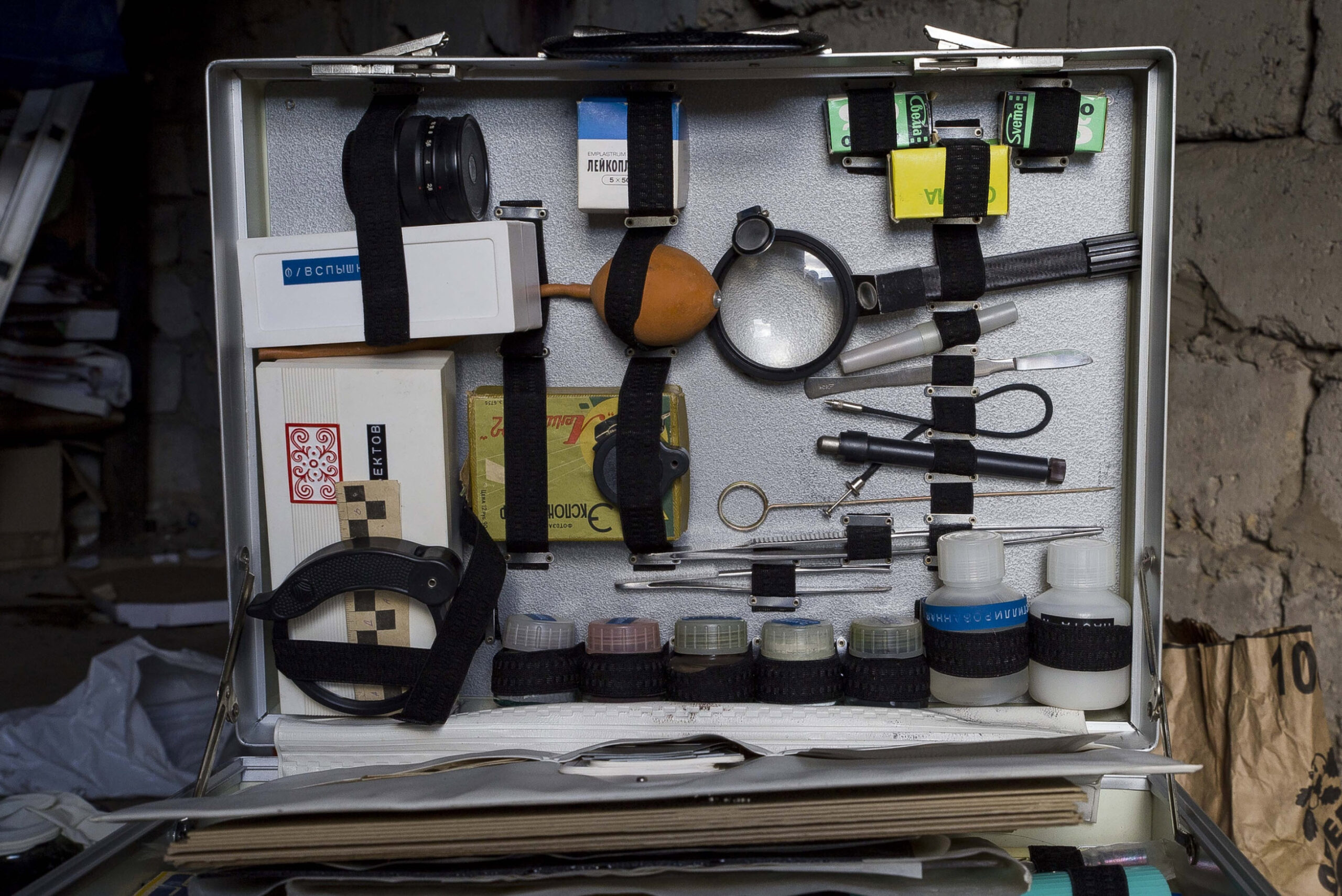
Soviet-era forensic tools suitcase with a top-secret instruction book showing Unit 34435 as its owner, issue 1982. Photo from VKontakte / Stariye Fotoapparaty.
While the unit’s legitimate purpose is forensic investigations, former Soviet and Russian intelligence officers who defected to the West have described it as also running a secretive poison laboratory which, during the Soviet era manufactured poisons used for assassinations of Western diplomats, Ukranian nationalists and Soviet defectors. Former KGB general Oleg Kalugin told The Guardian in 2018 that one of the first projects by this KGB lab was preparing the ricin-filled micro ball used to assassinate Bulgarian emigre writer Georgi Markov, killed in London in 1979.
A former KGB officer currently residing in the US who requested to remain anonymous confirmed to Bellingcat that KGB’s main poison-producing lab was located at the same site which this investigation has identified, based on voluminous geolocated telephone metadata, as the center of operations for the current FSB poisoning program run by the Criminalistics Institute. The same person also claimed that the site of the KGB lab was so secretive that it was also used as a situation room by the KGB and military hardliners who organized the putsch against Russian President Mikhail Gorbachev in August 1991. The same assertion – and the exact address of the secret laboratory – “ Akademika Vargi Street 2” – is contained in a statement by Oleg Kalugin quoted in 2004 by the Russian newspaper Novaya Gazeta.
A comprehensive analysis of phone metadata and travel data of a total of 12 FSB operatives linked to the Criminalistics Institute paints a picture of a specialized chemical weapons facility, run within this institute, that has a similar profile to that of the KGB-run laboratory described by the aforementioned Soviet-era ex-KGB officers. Furthermore, geolocated telephone data shows that members of this unit operate primarily out of a secure facility with an address on Akademika Vargi – identical to the address named by the two KGB former officers. The telephone metadata also pinpoints a second location that the operatives from this unit spend a significant amount of time at: a secretive, highly secured FSB compound just outside Moscow, in the Stroitel micro-district of the city of Mytishchi. A third location frequently visited by the operatives is the administrative headquarters of the Criminalistics Institute’s parent entity, the Special Technology Center, located at Prospekt Vernadskogo 12.

Map showing the various FSB-related facilities related to the team trailing Navalny (Source: Yandex)

Drone footage of the secure facility on Akademiki Vargi (Source: The Insider)
Based on analysis of metadata from hundreds of thousands of phone connections, it appears that this program is supervised by Col. Stanislav Makshakov, a military scientist who previously worked at the State Organic Synthesis institute in the closed military town of Shikhany-1, also known as military unit 61469. Until the official termination of Russia’s chemical weapons program, this military institute provided research and development for new forms of chemical weapons, including nerve agents of the Novichok type as part of a total of 21 highly poisonous substances. Makshakov’s position within the operation is made clear based on his extensive experience, and the chronology of phone calls between on-the-ground team members and his superiors, including General Kirill Vasilyev and General Vladimir Bogdanov. The order and frequency of these calls indicates that these operatives were reporting up or consulting with Makshakov, and he serves a common link between both chemical weapon experts working out of Moscow and the on-the-ground operatives trailing Navalny across Russia.
Col. Makshakov reports to General Kirill Vasilyev, director of the FSB Criminalistics Institute. Vasilyev is a chemical engineer and specialist in, among other things, identification of substance metabolites in biomedical samples through mass chromatography and mass-spectrometric detection (the golden standard for identification of chemical weapons in biomedical samples). Without disclosing his FSB affiliation, he has also co-authored studies for SC Signal, the research institute we previously identified as linked to Russia’s resumed chemical weapons program.

Author page for a scientific study with Kirill Vasilyev’s name, linked to the SC Signal institute. Source: Asu.ru
Kirill Vasilyev is subordinate to major-general Vladimir Bogdanov, former chief of the Criminalistics Institute and currently head of its parent entity, the FSB’s ‘Special Technology Center’ He is also deputy director of FSB’s powerful Scientific-Technical Service.

General Vladimir Bogdanov in a rare TV-interview from 2007 when he still chaired the FSB Criminalistics Institute. In this interview he can be heard describing the Institute’s role as spearheading “the fight against espionage and extremism”.
Bogdanov reports to the Director of the FSB, Alexander Bortnikov, who, in turn, reports to the President of Russia, Vladimir Putin.
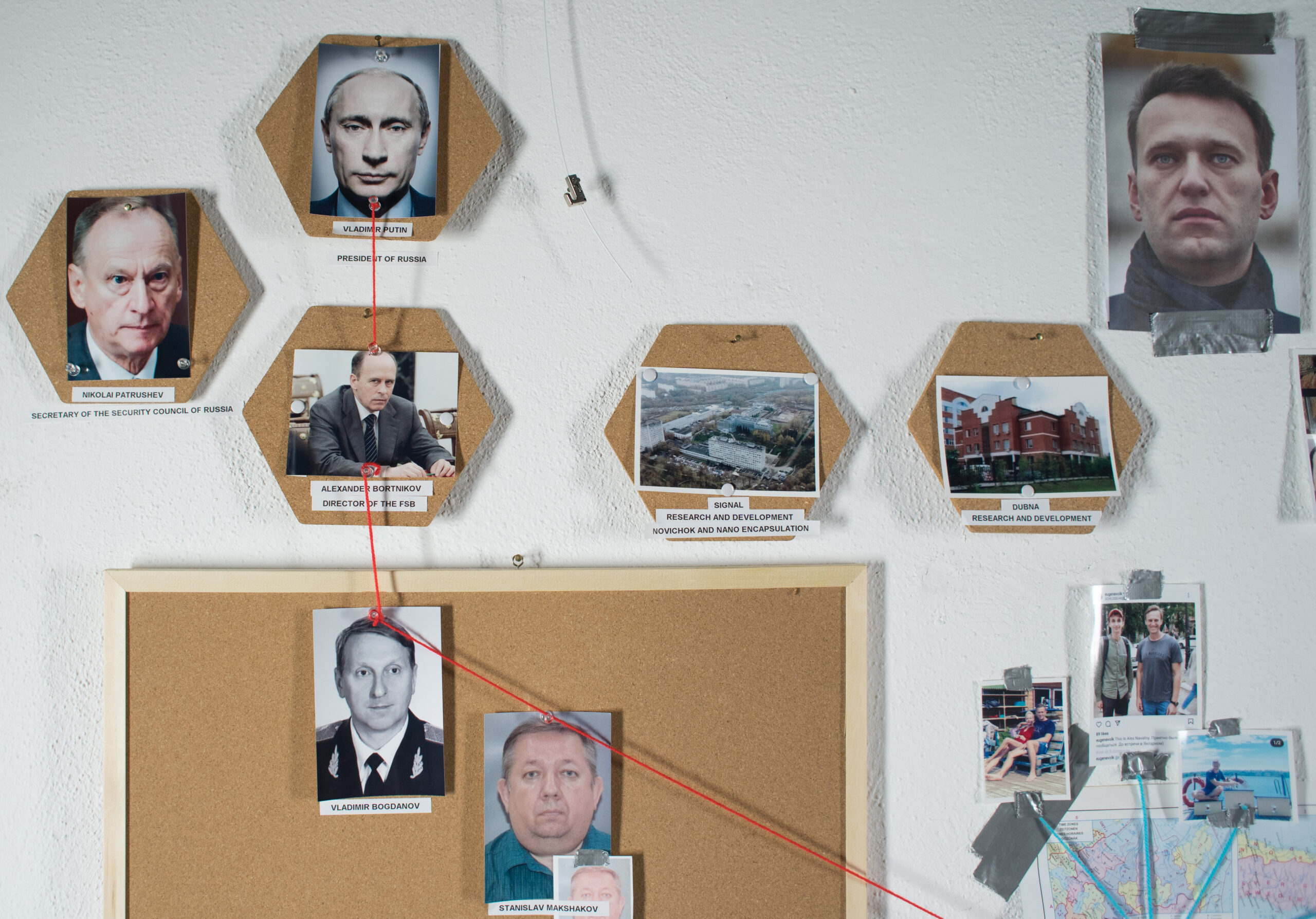
Leadership structure above the FSB team detailed in this investigation.
Click to view in full resolution. Source: Bellingcat
The FSB Squad
By analyzing call metadata, overlapping flight records and previously leaked offline databases, we have identified at least 15 operatives who appear to work within this clandestine sub-unit of the FSB Criminalistics Institute. At least eight of these – including Makshakov – were in close contact at various stages of the operations to tail Navalny and in the days and hours prior to his poisoning.
It also appears that attempts may have been made to poison Navalny on at least one and possibly two more occasions. Phone data shows that these operatives are in regular communication with Stanislav Makshakov and work primarily out of the same two locations on Akademika Vargi and in the suburb of Mytischi. The operatives hail from different backgrounds: some have medical degrees; others have chemical weapons military background, and several others have special operations skills.
The core team involved in following Navalny consists of seven operatives that appear to be in regular contact with Makshakov, a higher-ranking FSB officer. They traveled under their own or under a cover identity, depending on the sensitivity of the operation. The core team consists of the following individuals:
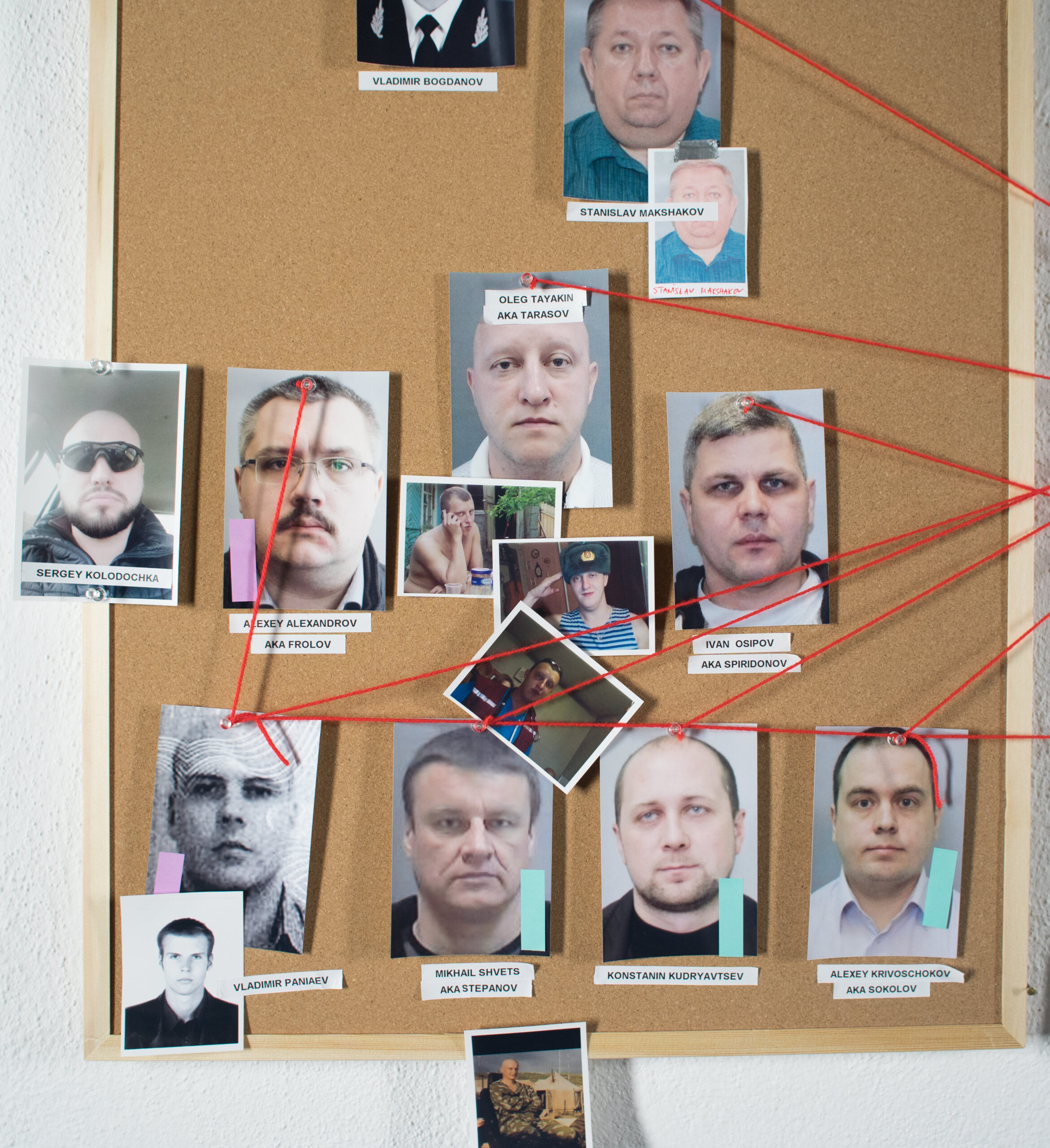
FSB team involved in the Navalny operation.
Click to view in full resolution. Source: Bellingcat
Oleg Tayakin, cover name Oleg “Tarasov”, born 6 December 1980
A senior member of the FSB squad, typically coordinating other officers and operating primarily out of the central office on Akademika Vargi. He served at an FSB-affiliated spetsnaz base (military unit 2006 in the southern Russian town of Yessentuki), as well as in the space-force military unit 03523. In 2004 he graduated from the Pirogov Medical Academy in Moscow. He worked as a surgeon before joining the FSB’s Criminalistics Institute.
Alexey Alexandrov, cover name “Alexey Frolov”, born 16 June 1981
Graduated medical school in Moscow in 2006 and worked as an emergency doctor and later as a military doctor before joining the FSB in 2013. He was present at both 2020 poisonings, one suspected by Navalny and his wife in Kaliningrad and the other near-fatal one in Tomsk, and operated under deep cover with a fake name and apparently burner phones. Alexandrov/Frolov appears to be a key member of the FSB team of operatives and chemical weapon experts, judging by his physical proximity to Navalny, the fact that he was traveling under a cover identity, and his phone contacts during his week trailing Navalny in Siberia.
Ivan Osipov, cover name Ivan “Spiridonov”, born on 21 August 1976.
Medical doctor by training. His social media presence disappeared in 2012, which is likely when he joined FSB.
Konstantin Kudryavtsev, cover name Konstantin “Sokolov”, born 28 April 1980.
Served at a chemical warfare military unit in Shikhany. Graduated Russia’s Military Chemical-Biological Defense Academy before joining the FSB’s Criminalistics Institute.
Alexey Krivoschekov, born 11 April 1979.
Worked at the Ministry of Defense prior to joining the FSB in or around 2008.
Mikhail Shvets, cover name Mikhail “Stepanov”, born 3 May 1977
His current registered address is at 116 Trubetskaya St, Balashikha – the address of FSB’s Center for Special Operations. As Bellingcat reported earlier, Vadim Krasikov, indicted in Germany over the FSB-organized 2019 execution of a Chechen-Georgian asylum seeker In Berlin, spent several days at this base immediately before his trip to Germany. Telephone metadata shows that Shvets splits his time between working at the special operations base and the Vargi lab.
Vladimir Panyaev, born on 25 November 1980 in Serdobsk, Penza Oblast
Served in FSB’s border service, then co-founded a company selling anti-bacterial lamps, before joining the FSB’s Criminalistics Institute. Likely coincidentally, lives in the same apartment building as Navalny. After the poisoning in Tomsk, his address registration was changed to that of the FSB headquarters, Lubyanka 1.
Prior to 2017, members of this FSB unit took joint multiple group trips to different destinations in Russia. Oftentimes they travelled to areas typically of interest to the FSB due to separatist or terrorist activities such as in Chechnya, Dagestan and North Ossetia. However, there were also many trips to other areas of Russia that have no known civil unrest, such as the Siberian cities of Omsk and Barnaul. It is not yet clear what task this specialized unit may have pursued in those regions. Phone data from recent trips to Grozny and Mineralnye Vody show that the officers from this unit interact with regional FSB officers from military counterintelligence and anti-terrorism departments, and usually visit the regional FSB headquarters at their destination.

Flight showing Kudryavstev and Aleksandrov as co-travelers (i.e. their tickets were purchased together) in May 2014. Source: Cronos / Leaked travel database
While such trips continued after 2016, it appears that as of early 2017 this unit’s main focus shifted to one figure: Alexey Navalny.
Notably, members of this unit appear to have used their cover identities almost exclusively for work related to Navalny. Of the five cover identities we have been able to discover thus far, two are (fake-identity) passports that were ostensibly issued in 2003 and 2015 respectively, however travel records show that they were first used in early 2017 – namely when this FSB unit started tailing Navalny. The other three cover passports were issued in 2020 and were used exclusively for trips related to the Navalny operations in Kaliningrad and Tomsk.
Thirty-Seven Coincidences
An analysis of prior travels of the FSB squad members shows they have been shadowing Navalny since at least 16 January 2017, just a month after he announced his plans to run in the 2018 Russian presidential election. As part of his presidential bid, Navalny made over 20 campaign trips outside Moscow during 2017. Members of the squad tailed him on the majority of these, with the exception of a few day trips which did not require him to stay overnight at a destination. In total, the FSB squad made 37 trips to the same destinations that Navalny travelled to by plane or train between 2017 and 2020.
The squad members traveled usually in groups of two or three – mixing up not only different team members on various flights, but also alternating their real and cover identities. They sometimes travelled under one identity in a certain direction and the other in the opposite direction. Notably, they almost never took the same flight as the one on which the opposition politician was flying but instead flew on parallel flights, preferably from and to other Moscow airports. More frequently than not, they also took a flight preceding – sometimes by one day – the arrival of Navalny to a certain destination.
Such a modus operandi would be in keeping with professional operational security practices to minimize chances of Navalny or his team members noticing the same fellow passengers on various flights. Similarly, this consistently applied method would likely make it implausible that this squad was tasked with simply tailing and surveilling Navalny, as such a goal – in addition to not requiring officers trained in medicine and chemical weapons use – would conceivably be better achieved by a larger number of FSB officers flying on the same flight as him.
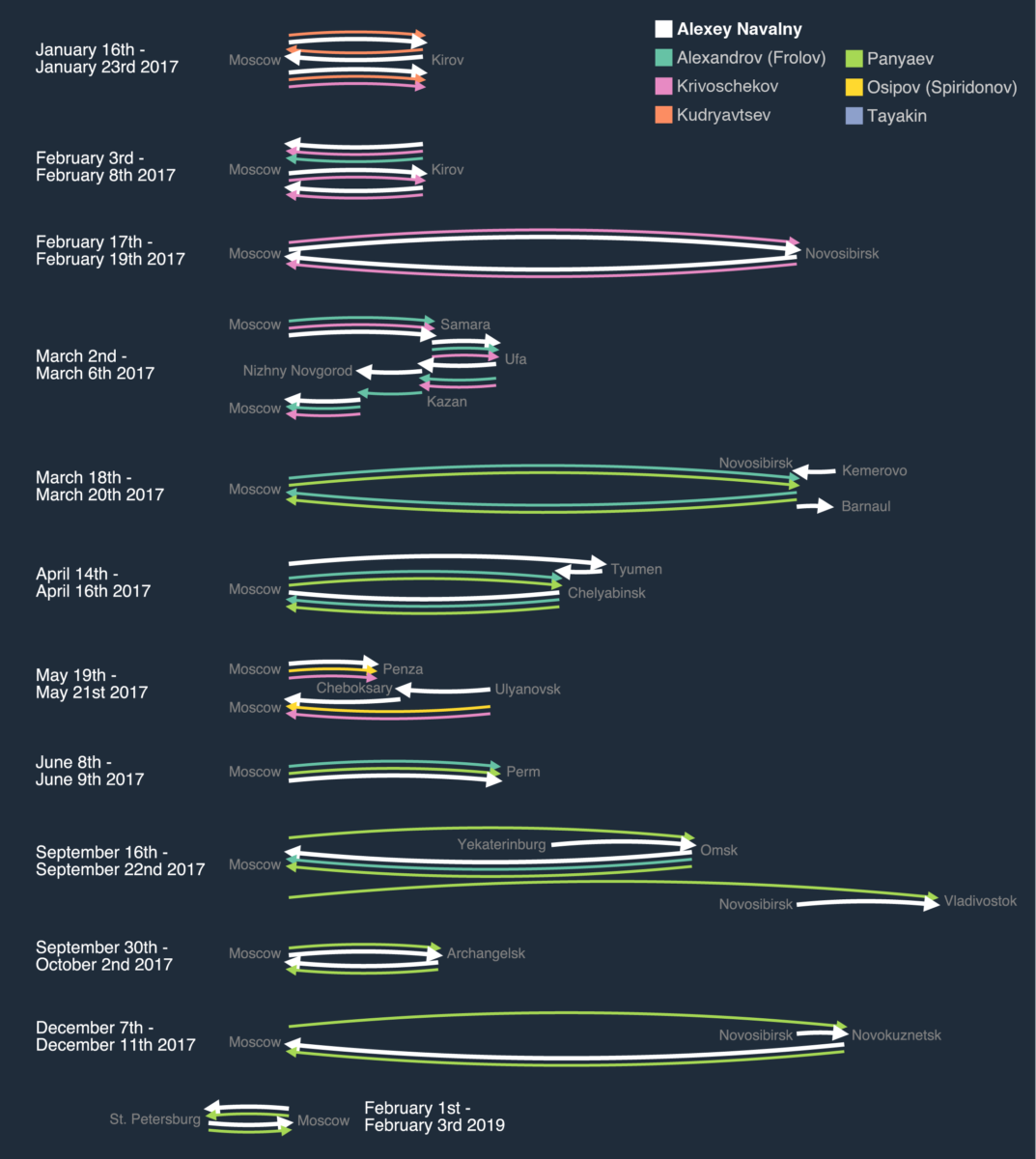
Infographic showing the common flights between Navalny and various FSB operatives. Click to view in full resolution. Source: Bellingcat
In fact, of all the group trips undertaken by members of this FSB team during 2017, there was only one that did not overlap with a trip taken by Navalny. On 27 April 2017, the officers Alexey Alexandrov (travelling under the fake identity as “Frolov”) and Vladimir Panyaev (travelling under his real identity) flew from Moscow to the southern Russian city of Astrakhan, and returned two days later, on 29 April 2017.
But Navalny did not travel to Astrakhan. As he wrote on his blog on 28 April 2017, he had purchased a ticket and planned to fly to Astrakhan on that morning in order to oversee the opening of a local electoral headquarters in the city. His trip was made impossible due to a severe eye inflammation following an attack on him the previous day in which an unidentified person threw a corrosive antiseptic substance at his face as he walked out of his office in Moscow (as a consequence of this attack he required surgery in his right eye).

Source: Yevgeny Feldman / Eto Navalny Project
The exact intent of the FSB squad consistently shadowing Navalny during his 2017 presidential campaign is not clear. Russian security experts including a retired Russian security officer consulted by Bellingcat suggested that the officers may have been tailing the opposition figure in order to establish a pattern of behavior in order to plan for a potential future poisoning operation. Alternatively, the team may have been deployed onto a permanent “stand-by” mode, in anticipation of a potential decision to target Navalny.
After the intense 2017 tailing operation, the members of the FSB appear to terminate their trips as of late 2017. In December 2017, Russia’s Electoral Committee refused to certify Navalny’s nomination as an official candidate, citing his criminal record in a case involving Kirovles, a state-owned timber company. This alleged embezzlement case was overturned by the European Court of Human Rights as lacking an element of a crime, but resulted in a re-trial in Russia that substantially repeated the original case. Navalny also informed Bellingcat that he made very few, if any, domestic trips in 2018.
Then in February 2019, a member of this FSB team took an overlapping train trip to St. Petersburg alongside Navalny. This seems to have been the only such case that year.
However, it is possible that other, yet unidentified members (or unknown cover identities of known members) of the FSB squad have taken more trips with the politician. In an interview with Bellingcat, Navalny shared previously undisclosed information that during a long-haul flight in 2019 (he could not remember the exact destination) he felt symptoms that he described as very similar in nature – while much less severe – than those that culminated in his near-fatal coma during his flight from Tomsk on 20 August 2020. By his recollection, he then spent some time in the airplane restroom until the symptoms began dissipating. As the symptoms had gone by the time he arrived, he did not assume he had been purposely poisoned and did not seek medical assistance; and the significance of that prior incident only became relevant to him after he recovered from his coma following the 2020 poisoning.
Other than the St. Petersburg trip, it has not been possible to match any flights Navalny took in 2019 with trips made by the known identities of the FSB squad.
On 28 July 2019, while he was in detention charged with organizing an unauthorized protest rally, Navalny suffered severe skin rash and eye inflammation which, according to his doctor, might have come from touching an unidentified chemical agent. He was hospitalized and diagnosed with contact dermatitis, and was returned to prison a day later after official government medical experts said they found no traces of poison in his blood samples. His request for law enforcement to investigate the case was not answered.
The Kaliningrad Fiasco
While this investigation into the FSB squad’s targeting of Navalny prior to 2020 is limited to train and flight data, documentation of their 2020 operations is significantly more granular thanks to raw telephone call metadata concerning several members of the unit. Analysis of the call logs – which in many instances included cell-tower geolocation data – allowed the reconstruction of the unit’s communications during the time Navalny was poisoned in Tomsk and another potential attempt to poison Navalny. In the latter case, reported here for the first time, Alexey Navalny’s wife Yuliya Navalnaya encountered similar symptoms during a trip she made with her husband.

Yulia and Alexey Navalny’s (and a few FSB officers’) Kaliningrad trip, Click to view in full resolution. Source: Bellingcat
Less than two months before Navalny’s poisoning in Tomsk, on 2 July 2020, three members of the FSB squad – Alexandrov, traveling under his fake name “Frolov”, Shvets and Panyaev traveling under their real names – bought tickets for flights to Kaliningrad, Russia’s Baltic Sea exclave sandwiched between Poland and Lithuania. Panyaev bought a ticket for a flight that same evening, while “Frolov” and Shvets bought tickets for the flight the following morning, 3 July. That was the day that Alexey Navalny and his wife Yuliya would fly to Kaliningrad for a five-day romantic getaway at a spa hotel on the beach, the Schloss Yantarny Hotel. As on many of his previous – unbeknownst to him – joint trips with the FSB specialists, Navalny’s covert companions would fly from a different airport, likely to avoid detection. He and his wife flew from Moscow’s Domodedovo airport, while “Frolov” and Shvets took a flight near the same time from Moscow’s Sheremetyevo airport.
Just before their flights, all three FSB operatives had exchanged multiple phone calls with Col. Makshakov. He in turn had exchanged phone calls with his bosses, Kirill Vasilyev and Vladimir Bogdanov. Once the three operatives left Moscow, they turned off their regular phones and did not switch them back on until they had returned. However, at least one of them – by all indications, that of Alexandrov/”Frolov” – used a burner number to communicate with his commander Makshakov throughout the operation.
In both the Kaliningrad and later Tomsk operations, Aleksandrov turned off his main phone right after he left Moscow. He appears to have used this burner phone for the duration of the operation, talking to the same individuals as he does on his main phone line, and then returned to using his real phone after returning to Moscow. In a few mishaps, he accidentally turned on his real phone while on his operation — later in this investigation, we will detail how a couple of accidental pings revealed his locations in Novosibirsk and Tomsk.
On 3 July 2020, Makshakov received several text messages between 3 pm and 6 pm Moscow time, and one final SMS just after midnight. The communication intensified the next day, with a total of 21 text messages through the day, the last of which was at 4:57 am the following morning (3:57 am local time in Kaliningrad). Earlier that night at 11:21 pm, all three squad members had booked tickets back to Moscow in the late afternoon on the following day, 5 July. After a few more text messages throughout the day, the trio flew back to Moscow together at 4:55 pm. Upon arrival at the airport, Alexandrov called Makshakov and, as seen from his telephone metadata, went to the Vargi office.
The next day, 6 July 2020, two separate storylines developed, one in Kaliningrad and another in Moscow.
As reconstructed from two separate interviews with Alexey and Yuliya Navalny, early on the morning of 6 July – the fourth day of their vacation in Kaliningrad – they decided to take a long walk along the beach. They returned briefly to their hotel room and then went out to have а late lunch in a nearby beachside cafe. Along the way to the cafe, Yuliya Navalnaya suddenly felt weak. As they reached the cafe and without any warning symptoms, In her words “I felt sicker than I had ever felt in my life”. Her husband asked her what was wrong and if she felt any pain, but she could not pinpoint any particular part of her body that ached. She drank some water and said she would walk back to the hotel to have a rest, while Alexey Navalny remained at the cafe. The fact that Yulia Navalnaya felt unwell was confirmed by recollections by the Kactus cafe manager in a phone call to Alexey Navalny.
On the way back, she briefly sat on a bench and found it nearly impossible to stand up. She says she could hardly control her legs as she walked the mere 300 meters to the hotel and into her room. She lay on the bed, overcome by her undetermined illness. After her husband returned, she decided to go back to sleep. She only recovered when she had woken up the following morning.
Both Alexey and Yuliya Navalny told Bellingcat that they did not feel they should seek medical assistance due to the undefined nature of her illness. Alexey Navalny believes that the mysterious sickness his wife describes is very similar to the “feeling of impending death” that he experienced on board the airplane on 20 August after being poisoned with Novichok. According to a 1992 paper by the chemical weapons experts F.R. Sidell and J. Borak, cholinesterase inhibitors like Novichok may leave a target largely asymptomatic “until the […] AChE [cholinesterase] activity is inhibited by 75 to 80 percent”; meaning that a non-lethal dose of the agent may lead to only temporary or partial motor or respiratory impairment.
While Yuliya Navalnaya was beset by her inexplicable symptoms, there was a surge of telephone activity in Moscow. Starting at 8:30 on the morning of 6 July 2020, there was a crossfire of phone calls among the three squad members who had just returned from Kaliningrad and their boss Makshakov, who in turn called his own superiors Kirill Vasiliyev and Gen. Bogdanov. By 9 am, Makshakov, Vasiliev and Bogdanov had all called Artur Zhirov, the director of SC Signal. Just after 10 am, Zhirov, and after that, Makshakov, both telephoned Oleg Demidov, a chemical weapons expert formerly from the Shikhany-based 33rd Military Institute. Oleg Demidov has co-authored several chemical-weapons related patents for the 33rd Institute, including a 2003 patent for “imitation recipe for combat training under chemical attack conditions”. Following his formal retirement from the 33 Institute, he spent several years working at the Dubna-based “Institute for Applied Acoustics”, a state-owned institute that formally has no activity linked to chemical weapons, but which was visited by the FSB’s squad members Tayakin and Alexandrov in May and June 2020, phone records show. As of 2019, Demidov is employed by SC Signal, and is in frequent telephone communication with at least five members of the FSB squad.
Following a hectic exchange of calls between the FSB and SC Signal during the first half of the day, just after 1 pm Gen. Bogdanov headed to the airport and departed to Kaliningrad at 2:30 pm. Geolocation data shows that he spent the next several days at the FSB headquarters in the Russian exclave, communicating by phone primarily with Makshakov, as well as with chemists at SC Signal and the Criminalistics Institute.
While the surge of telephone communication on 6 July 2020, and the subsequent trip by Bogdanov to Kaliningrad, cannot on their own be conclusively linked to Navalny, there is a clear pattern with previous trips that indicates that the trip by the FSB squad – with Alexandrov travelling under a cover identity – was part of an operation targeting the opposition figure. Given the correlated surge in communication between members of the FSB squad and its commanders, and SC Signal (NB: the communication on 6 July was highly unusual and was the only time Bogdanov called SC Signal’s chief Zhirov in the period from May to November 2020), it is logical to assume that chemical-weapons experts from SC SIgnal were involved either in the planning of this operation, or potentially in a post-mortem, and the planning for a future attempt to poison Navalny.
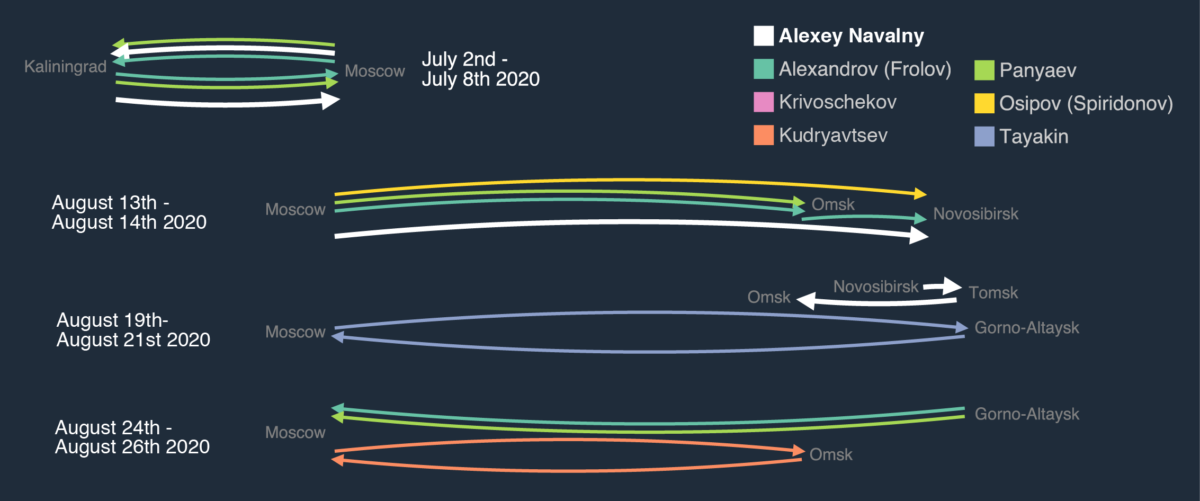
Infographic detailing the travel itineraries of Navalny and a number of FSB operatives in Kaliningrad and Siberia during the Navalny poison incidents. Source: Bellingcat
A Final Attempt

Click to view in full resolution. Source: Bellingcat
At 1:39 pm on 12 August 2020, three FSB squad members – Alexandrov, Osipov and Panyaev – booked flights for the next morning to Novosibirsk. Alexandrov would fly as “Frolov” and Osipov as “Spiridonov”. Only Panyaev would use his real name. The destination – four time zones away to the east, in Siberia – was not randomly chosen. By this time the FSB would have known that a key member of Navalny’s Anti-Corruption Foundation (FBK) team – the head of its investigation unit, Maria Pevchikh – had purchased a ticket to Novosibirsk. Earlier that day, on 12 August, the core FBK team had gathered in their office to discuss their travel plans.
What the FSB squad could not have known was exactly what would happen after the trip to Novosibirsk. Navalny and his team had not booked return flights. Following multiple security incidents including the antiseptic dye that damaged his eyesight and the perceived poisoning in detention in 2019, he preferred to keep his and his team’s travel plans obscured from prying eyes, and routinely make last-minute bookings. Navalny would only book a return flight – not from Novosibirsk, but from Tomsk – on 17 August 2020.
That was not known to the FSB team as of 12 August, so they booked one-way tickets to Novosibirsk. They would only book their return flights five days later – minutes after Navalny booked his own return flight on 17 August. Like Navalny, the FSB squad would fly back to Moscow from Tomsk, but a day later than him, on 21 August.
Immediately after the three FSB squad members made their outward flight bookings, Osipov called Col. Makshakov, who in turn promptly called his boss Kirill Vasilyev, the head of the Criminalistics Institute. In the next few hours, there was a continuous exchange of calls among Makshakov and the three core team members who had booked flights to Novosibirsk, as well as the other squad members Krivoshchekov, Kudryavtsev and Shvets.
As the evening approached, another squad member – Oleg Tayakin – called the three members who would fly the next morning. Call records from later that week show that Tayakin would stay in Moscow and would communicate with an unknown person back and forth via secure messenger.
Later that evening, at 8:43 pm, Makshakov called major-general Vladimir Bogdanov of the FSB’s Special Technology Center. Shortly after that, one of the departing team members called the FSB station chief at Sheremetyevo Airport. The next morning the trio would depart from there.
As Alexandrov, Osipov and Panyaev took flight SU-1460 from Sheremetyevo to Novosibirsk at 9:05 am, their colleague Tayakin headed from the Vargi office to another Moscow Airport, Domodedovo. Geolocation data from his phone shows that he lingered at the airport without calling anyone. He stayed there until just after 11:00 am and then returned to the main office at Vargi. One flight departed from Domodedovo to Novosibirsk at 11:20 am. On it was Pevchikh, FBK’s lead investigator. Months later, surveillance footage leaked to a Russian state-owned TV channel would show that Pevchikh had been tailed and surveilled throughout the day, starting from the moment she left her Moscow apartment early that morning.
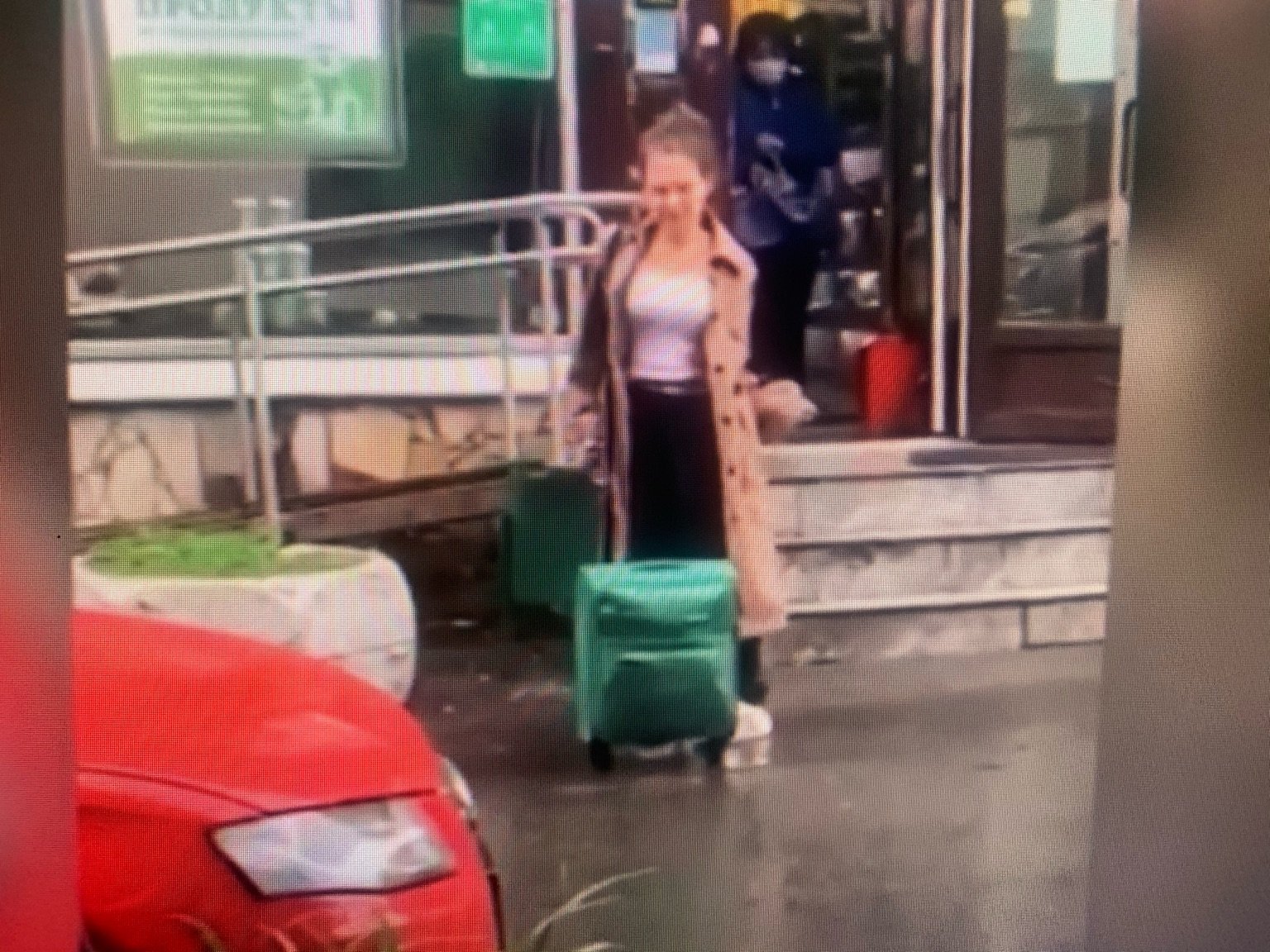
Hidden surveillance footage showing Maria Pevchikh leave her home early on the morning of her trip to Novosibirsk; footage leaked to Russian TV channel Ren TV
On the following day, 14 August 2020, at 3:34 pm Tomsk time, Alexandrov made one of two serious operational security errors. He briefly turned on his main phone, leading to a ping of geolocation data. At this point in time, he was located near a base station at Prospekt Dimitrova 2 – near the hotel where Maria Pevchikh had booked a room. The phone would have also been within cell tower service of another hotel – the one where Navalny and his team would check in later that day.
Call records from the following three days indicate that Oleg Tayakin would stay at the main headquarters on Vargi in Moscow, only briefly going home twice during this period. Throughout most nights, he continuously made and received secure voice-over-ip phone calls with an unknown individual. He would call Makshakov early every morning. Makshakov, in turn, would call Bogdanov after each incoming call from Tayakin.
One Stray Byte in Tomsk
Due to the fact that apparently Alexandrov – and likely the other two members of the team – used new burner phones during the trip to Siberia, Bellingcat and its partners have not yet been able to determine their exact movements beyond the flight booking information obtained and their incidental failures to comply with security protocols.
However, call data from the other unit members who used their regular phones indicates that their operation had two periods of particularly high activity – one on the evening of 16 August and one on the night of 19 August 2020. This can be deduced both from the frequency of the interactions as well as the appearance of night-time calls between Makshakov and his bosses, on the one hand, and Tayakin, Kudryavtsev and Krivoshekov, on the other.
The first peak – on 16 August – came during Navalny’s last full day in Novosibirsk. The next day, he and his team would drive to Tomsk, а three and a half hour ride north.
Late on the previous evening, 15 August, back in Moscow – at 11:07 pm – Bogdanov had called Makshakov. Throughout that night – which would have been early morning in Novosibirsk – Bogdanov and Makshakov exchanged several other text messages between 3 am and 5 am Moscow time (7 am – 9 am Novosibirsk time), interspersed with text messages between Makshakov and the squad members Shvets and Krivoschekov.
Navalny and his team later booked their return flights from Tomsk to Moscow for the morning flight on 20 August. Shortly after, airline booking data shows, the FSB team bought their tickets from Tomsk to Moscow for 21 August.
The second surge in overnight communication took place on the night of 19 August – this would appear to coincide with the window of time in which Navalny was poisoned in Tomsk.
At 4:21 pm Moscow time (8:21 pm Tomsk time), Vladimir Panyaev sent a text to Makshakov. This was the third text Panyaev would send his superior on that day, the first two were sent early in the morning. Shortly after this text was sent, Navalny went swimming in a local river in the Tomsk area – a routine that had turned into a ritual during all of his trips with the FBK team. He was away from the hotel – and his room was left unattended – for about 2.5 hours. He returned to the Xander Hotel at 11 pm and met his team – who had just finished their dinner at the hotel’s Velvet Bar.
As they all sat at the bar, at about 11:15 pm, Navalny ordered a Bloody Mary. The bartender surprised him by saying they didn’t have the necessary ingredients, and offered a Negroni cocktail instead. Navalny accepted the suggestion, but told us he couldn’t take more than one sip as “the cocktail tasted like the most disgusting thing I’ve had in my life”. About 15 minutes later he left the party and headed for his room. Just after midnight, Maria Pevchikh sent him a text message with some follow-up questions for her work, as she was supposed to stay in the area to complete an anti-corruption documentary film. He didn’t reply, as he had gone to bed.
At about the same time, 8:08 pm Moscow time, Krivoschekov called Makshakov. At 8:37 pm Tayakin communicated briefly with someone via messenger. Shortly thereafter he called Makshakov while carrying on a data connection at the same time. He spoke with Makshakov four times in the next few minutes, the last time at 8:44 pm. This would have been 12:44 am in Tomsk.
Four minutes later, at 12:48 am, Alexandrov made his second operational-security blunder. He turned on his regular telephone, again. The phone was on for a brief second only, but that was long enough for it to exchange one single byte of data with the cell phone network. The telephone data reviewed by our investigative team for this phone places the device near a cell phone tower in central Tomsk, just a short drive north of the Xander Hotel. Below, a map shows the triangulation data noting the location of the device north of Navalny’s hotel on the night of the poisoning.
The Frenzied Morning After
At 6:00 am on 20 August 2020, Navalny’s team had gathered in the lobby and was waiting for him to come down from his room to leave for the airport with his aide Kira Yarmysh. A taxi had been ordered. But Navalny was late – which was out of character for him. However, he did appear at 6:05 am.
Exactly then – at 2:05 am Moscow time – Krivoschekov sent a text message to Makshakov. Makshakov then texted Tayakin – who was at home. Tayakin promptly texted back at 2:08 am, and headed for the office at about 3:40 am. He arrived at Vargi just under an hour later. In the meantime – at 4 am Moscow time – Navalny’s plane had taken off from Tomsk to Domodedovo Airport in Moscow.
About 30 minutes into the flight, Navalny felt the onset of severe poisoning and collapsed into a coma after trying to freshen himself up in the airplane restroom. The pilot diverted the plane to the nearest airport – Omsk – at about 5:15 am Moscow time, and after a short initial delay due to a fake bomb alert at the airport, the pilot was able to land the plane at 6 am Moscow time. Emergency medical staff arrived promptly and administered atropin to Navalny – a measure that German doctors have called life-saving.
At exactly 6 am, Makshakov called Krivoshchekov. At 7:11 am, Makshakov called major general Bogdanov.
In the meantime, at 5:36 am Tayakin had left the office and headed toward Domodedovo Airport. Cell phone data shows him close to the airport at about 6:27 am – but he stopped a few kilometers short of it. He made a voice-over-ip call from there and waited until just after 7 am, when he left without ever entering the airport area. At 7:06 am he drove back to the Vargi office and stayed there exchanging calls with Makshakov and other members of the team until, at 11:30 am, he went to Bogdanov’s office at Prospekt Vernadskogo 12. He stayed there for an hour and then drove back to Vargi.
Later that night, Tayakin also flew to Siberia. He had booked the ticket at 12:05 pm, during his stay at Bogdanov’s office.
Two Long-haul Pop-ins
Just after midnight on 20 August, as Navalny was in a critical condition at an Omsk hospital, Tayakin called the FSB station chief at Domodedovo Airport. At this point, he was approaching the airport, from where he would to fly to Gorno-Altaysk – a small town about five hours’ drive from Novosibirsk. He left Moscow at 2:40 am, and when he landed later that morning, headed straight for the FSB office in the city center.
We could not establish what Tayakin may have been doing in Gorno-Altaysk – a town of 60,000 people that is a nine hour drive from Tomsk and a 13 hour drive from Omsk. However, a nearby town – Byisk – is the home to a small institute – the Institute of Problems of Chemical Energy– that has a special relationship with the Criminalistics Institute. According to public procurement records, this institute has supplied the Criminalistics Institute with “services for manufacturing of pharmacological substances”, as well as “research and experimental services in the area of chemistry”. This institute also claimed the 2018 invention of a “nano-sorbent set for removing traces of chemical weapons from infected sites”. Crucially, at least one member of the FSB squad – Alexandrov, telephone records show, is in frequent telephone contact with a scientist from this institute: Mikhail Vasilishin – a chemical engineer with a focus on experimental chemical production capabilities.
Tayakin spent the remainder of the day at the FSB office in Gorno-Altaysk, possibly used a meeting place, and then moved to a resort area south of the city. At about 6 pm Moscow time, Tayakin and Makshakov began an exchange of text messages. The exchange ended at 6:21 pm.
At 7 pm, the Omsk hospital which had initially refused to let Navalny be flown to Germany for treatment, suddenly reversed its decision and permitted his medical evacuation.
Two days later, on 24 August, the three members of the FSB squad who had been in Tomsk at the time of his poisoning – Alexandrov, Osipov and Panyaev – followed suit, taking a flight from Gorno-Altaysk to Moscow.
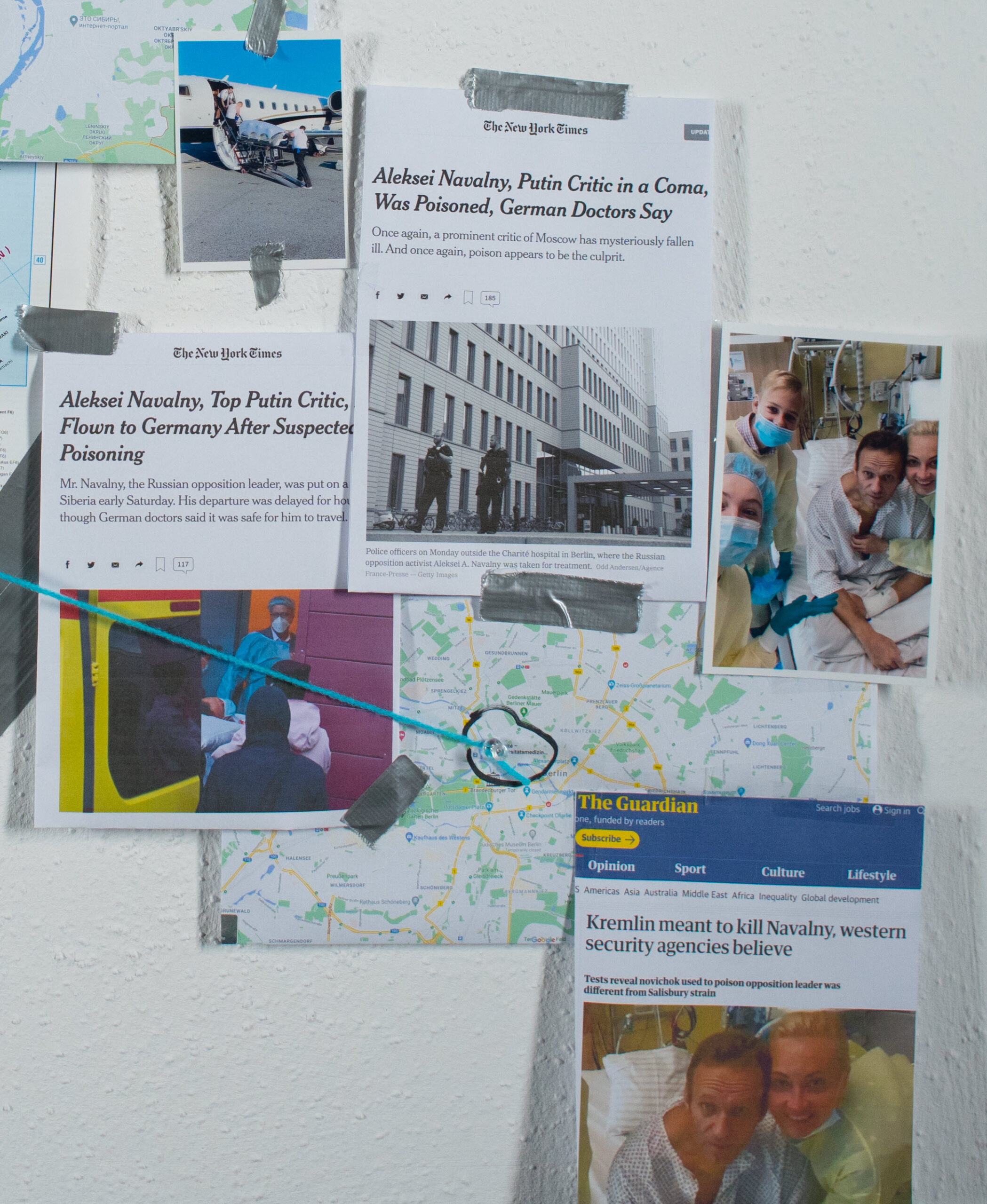
Click to view in full resolution
Tayakin’s pop-in to Gorno-altaysk – nearly 4,000 km away from Moscow – was not the only suprisingly short trip taken by a member of the FSB squad around the time of Navalny’s poisoning. Just a day after the trio of Alexandrov, Osipov and Panyaev arrived back to Moscow, their colleague Kudryavtsev – a trained chemical-weapons specialist – flew from Moscow to Omsk on 25 August 2020. He stayed in the town for less than 10 hours, driving from the airport to a downtown area and leaving back to Moscow later that same night.
At this point in time Navalny had already left Omsk and was beginning his long road to recovery in Berlin. However, his clothes and personal effects that had been with him at the Omsk hospital had remained there. And if any of them contained residues of the toxin Navalny was poisoned with, they would potentially serve to implicate his poisonors.
Until today, Navalny and his family have been not able to obtain an answer as to the whereabouts of his clothes.
Conclusion
This investigation has unearthed large volumes of data implicating Russia’s preeminent security agency, the FSB, in tailing Navalny over a long period of time using operatives that have specialized training in chemical weapons, chemistry and medicine – a skillset inconsistent with regular surveillance practices. These operatives were in the vicinity of the opposition activist in the days and hours of the time-range during which he was poisoned with a military-grade chemical weapon. They were in the vicinity of Navalny on at least one other occasion when a family member felt inexplicable symptoms consistent with a non-lethal, accidental dosage of the same toxin. They had previously tailed the opposition figure on over 37 trips in the last four years. Given this implausible series of coincidences, the burden of proof for an innocent explanation appears to rest purely with the Russian state.
This independent investigation, which will be expanded upon in future contributions, is particularly important given that no country has offered its jurisdiction to investigate the poisoning of Navalny, a political activist, blogger and former presidential candidate, with a banned chemical weapon. Such tacit refusal to investigate amounts to a deferral of the duty to investigate to Russia – a state that is not only implicated in the crime itself, but one which has officially declined to open a formal investigation.
The Bellingcat Investigative Team has assembled a timeline of movements, phone calls, and actions taken by the FSB operatives (Team 9) and by Alexey Navalny’s team.
We have also detailed the research methodology for this investigation in a separate article. You can read it here
Investigation from team of Bellingcat, CNN, Der Spiegel, and The Insider. Contributions from El Pais. Christo Grozev served as the primary researcher for Bellingcat, with contributions from Pieter van Huis, Aric Toler, and Yordan Tsalov.
